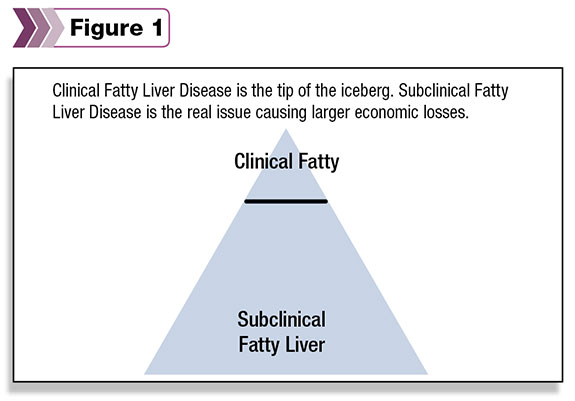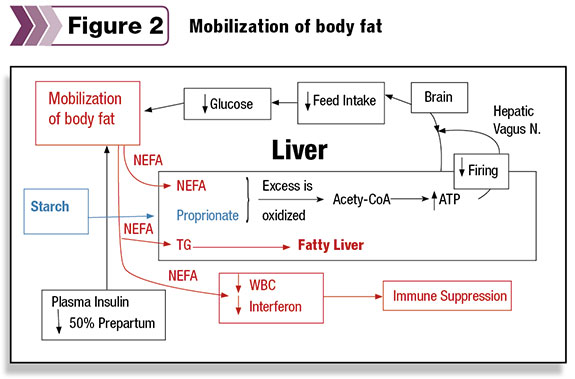The importance of post-fresh health in dairy cows has been well documented. Cows that get off to a good start peak higher, milk more, breed back quicker, have lower 60-day cull rates and are more profitable. There have been many articles written about ways to facilitate a good start.
Energy balance, protein balance, calcium supplements, mineral supplements and probiotic supplements have been suggested as the keys to fresh cow health.
It is our opinion that all of these are important, but the key to post-fresh cow health is understanding subclinical fatty liver disease (SFLD), the hepatic oxidative theory (HOT) and implementation of a post-fresh enhanced performance (PEP) program.
Subclinical fatty liver disease

It is estimated that 30 to 70 percent of all fresh cows suffer from subclinical fatty liver disease ( Figure 1 ).
Subclinical fatty liver disease occurs around freshening when the cow is not able to meet her energy needs and mobilizes fat from fat reserves.
One of the components of fat mobilization is the production of non-esterified fatty acids (NEFAs). NEFAs are used as an energy source for maternal and fetal tissue.
Elevated NEFA levels can depress feed intake and suppress immune function.
The effect on immune suppression is profound. NEFAs have been shown to interfere with interferon and white blood cell function.
Another effect of negative energy balance is that fat can be deposited in the liver, thus interfering with the normal functions of the liver. A fatty liver can lead to decreased liver glucose production as well as imbalances in electrolytes such as calcium, phosphorus, magnesium and potassium.
Hepatic oxidative theory
The hepatic oxidative theory (HOT) is explained in an article by Michael S. Allen and B. J. Bradford titled “Nutritional Control of Feed Intake in Dairy Cattle.” Although it is only a theory, in our opinion it is consistent with practical experience.
HOT explains how the transition cow metabolizes excesses of NEFAs and propionate, which ultimately lead to decreased appetite in the post-fresh cow. Decreased appetite leads to less feed intake, causing the increased mobilization of fat and the formation of more NEFAs.
The amount and digestibility of the starch fed will determine if levels of its breakdown product, propionate, will be present in excessive levels. The excess NEFA and propionate are oxidized in the liver, leading to increased acetyl-CoA levels with elevated ATP.

The increased ATP translates to decreased firing of the hepatic vagus nerve, which then communicates to the brain a feeling of fullness (satiety).
Less feed intake leads to fat mobilization and thus a completion of the cycle. (See Figure 2 )
Several weeks before calving, insulin plasma levels decrease by 50 percent or more.
Decreased levels of insulin during the transition period are another factor causing excess NEFAs through fat mobilization.
Therefore, the goal in management is to find the right balance where flux of propionate meets the glucose needs of the cow without excess.
Starch concentrates can be lowered by substituting non-forage fiber sources for cereal grains. Common non-forage fiber sources used are beet pulp and soy hulls.
One can also change the form of starch in terms of digestibility. Dry corn reduces the rate of propionate production in the rumen compared to high-moisture corn.
Post-fresh enhanced program
We’ve designed the post-fresh enhanced performance (PEP) program to proactively treat and prevent the problems associated with subclinical fatty liver disease.
Traditionally, post-fresh programs were focused on running costly diagnostics and treating for various diseases (pasteurella, salmonella, BVD, BRSV, IBR and other viruses) based on fevers found in post-fresh cows.
It is our contention that a lot of money has been wasted by veterinarians and producers through treatment and vaccination in these post-fresh animals without addressing the real underlying issue.
We believe that the diseases are the end manifestations of the underlying immune suppression caused by undiagnosed subclinical fatty liver in the majority of these cases.
Many of these diseases could be prevented and productivity maximized by properly addressing the nutritional needs of this group of cows prior to freshening.
The PEP program is a comprehensive plan that has five main components. The five key steps are education, diagnosis, treatment, protocol documentation and monitoring:
1. The education component is designed for dairy owners, herdsmen and anyone associated with treating fresh cows. We believe that “you have to understand something in order to prevent and treat it.”
In this classroom part of the program, the different causes of fatty liver and HOT are discussed. It is our opinion that employees are better able to adopt and implement a program if they understand why their actions are important.
2. The diagnosis component is identifying post-fresh subclinical fatty liver cows in the herd. We’ve designed appetite scoring to be an accurate yet rapid diagnostic tool that limits confinement time to an hour or less so as to minimize stress.
We streamlined evaluations of the cows to get the most information in the shortest period of time. We place little emphasis on temperature taking.
The fact that cows are eating and may have a fever does not change how we proceed. Another advantage of aggressive appetite scoring is that if an abnormal trend is found in the post-fresh group, one can go back to the pre-fresh group and try to identify the problem immediately instead of waiting for DHIA records to return.
3. Treatment focuses on protocols addressing liver-related issues, specifically metritis. Metritis has been found to be the most common infectious disease associated with fatty liver cows.
Most treatments incorporate drenching cows with 10 to 12 gallons of water along with a fresh-pack of additives that includes calcium propionate, magnesium sulfate, potassium chloride and mono-sodium phosphate.
We choose to treat metritis with an appropriate antibiotic that has no milk withhold, thus avoiding a social move to the hospital pen that can lead to additional stress.
4. Protocol documentation – In this part of the program, a hard copy of treatment protocols is made to supplement pre-existing farm SOPs. The protocols are also incorporated into herd management software programs with appropriate milk and meat withdrawals.
Setting up the software can be time-consuming, but once it is done, compliance and accuracy of procedures greatly increase. A print-out of the fresh cows is produced every day which lists the previous day’s findings and needed treatments.
This is very important so different employees can communicate with each other about the status and changing needs of the fresh cows.
5. Monitoring helps the dairyman learn how to collect the information to monitor and evaluate the progress of fresh cow performance. Dairies also have the option to send us a backup of their cow files once a month to evaluate the performance of the fresh cows.
From the herds we have worked with in eastern Wisconsin, we learned it takes about 10 to 12 hours to implement PEP on the dairy. Successful implementation requires a cooperative working relationship between the veterinarian, the nutritionist and the producer.
In dairies with successful implementation of the PEP program, we have found the following: DA rate less than 2 percent, 60-day cull rates, less than 6 percent improvements in first-service conception rate and four-week milk averages, higher peak milk, reduction in number of animals with high first-test fat-to-protein ratios and reduction in metritis incidence and first-test SCC. PD
Sosalla and Krahn are veterinarians with Country Hills Animal Health.






